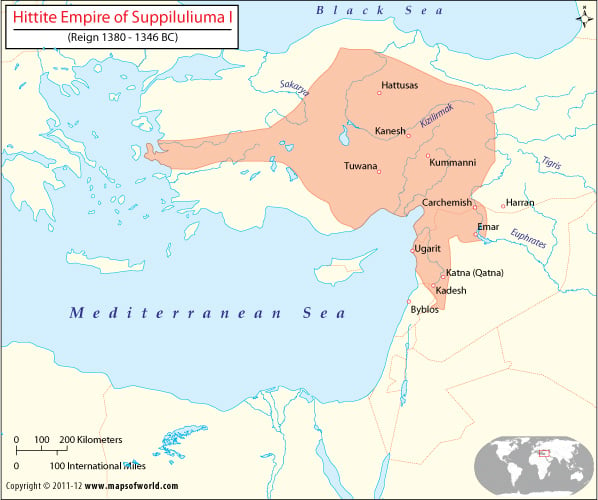The history of Asia Minor suggests that the Bronze Age brought frequent conflicts among the many city-states and saw much strife among the inhabitants of Anatolia. By the third millennium BC, an Indo-European tribe arrived in Anatolia and made the land its home. By the seventeenth century BC, the indigenous Hattians came into conflict with these Indo-Europeans who conquered the Hattians and imbibed much of their culture. These were the origins of the Hittite Empire.
In around 1650 BC, Anatolia saw the emergence of King Hattusili who conquered all the warring states and united them. He established his capital in Hattusha, and in an attempt to further his territories, declared war against the neighboring Arzawa and Hurrian kingdoms. Under Hattusili I, the Hittite Empire stretched across Anatolia to the northern fringes of Syria. The empire reached its greatest glory under the reign of King Suppiluliuma I (1380-1346 BC).
Discovering a Forgotten Civilization
For a long time, the Hittites were only known to historians as an obscure tribe mentioned in the Bible. In 1834, when archeologist Charles Texier stumbled upon the ruins of Hattusha (modern-day Boghazkoy), his discovery went unrecognized.
With time, historians and archeologists found ruins and inscriptions, similar to those in Hattusha, in many parts of Asia Minor, also known as Anatolia. This led them to suspect that there existed an important empire spanning from the shores of the Aegean Sea right up to the banks of Euphrates River. Reverend Archibald Henry Sayce, a British Assyriologist, revealed to the world the scope and importance of the Hittite Empire in a lecture in 1882.
Hittite-Egyptian Peace Treaty
Hugo Winckler and Theodore Makridi led excavations at the site of Hattusha in 1906. There they stumbled upon the peace treaty between the Egyptian Pharaoh Ramses II and the Hittite King Hattusili III. This is the oldest surviving record of a peace treaty in the world. While the Hittite version was preserved in cuneiform on clay tablets in Hattusha, the Egyptians engraved the treaty in hieroglyphics on the walls of the Temple of Amun in Karnak. Historians believe that the treaty was signed following the Battle of Kadesh in 1274 BC. Ramses II eventually married Hattusili III’s daughter, formally consolidating the cordial relations of the two countries.
The Language of the Hittites
While court records of the Hittite were written in Akkadian, the official language, other tablets found in Hattusha were in a language now referred to as Hittite. After many years of study, the linguist, Bedřich Hrozný deciphered Hittite. He confirmed in 1915 that Hittite was the oldest Indo-European language which has been preserved in writing. .
Hittite Religion and Culture:
The Hittites assimilated much of the culture and religious beliefs from the people they conquered, but they centered their traditions on the indigenous Hittite religion. The Hittites practiced a polytheistic religion and worshipped many natural forces. Tarhunt, the prime deity, was the storm god. He ruled the heavens with his consort, Arinna, the sun goddess. They presided over a pantheon of a thousand gods. The theory of divine origin of royalty found a strong proponent in King Hattusili I. He claimed that the gods had sent him as their representative and that he would intercede with the gods for the prosperity of his people.
The fall of the Hittite Empire by 1200 BC was sudden. With the death of King Hattusili III, the kingdom disintegrated and Hattusha was abandoned. The rise of the Neo-Hittite states such as Tabal and Kammanu to the north, and Hamath and Bit-Adini dominated most of the next century.

 Ancient Thrace Map
Ancient Thrace Map